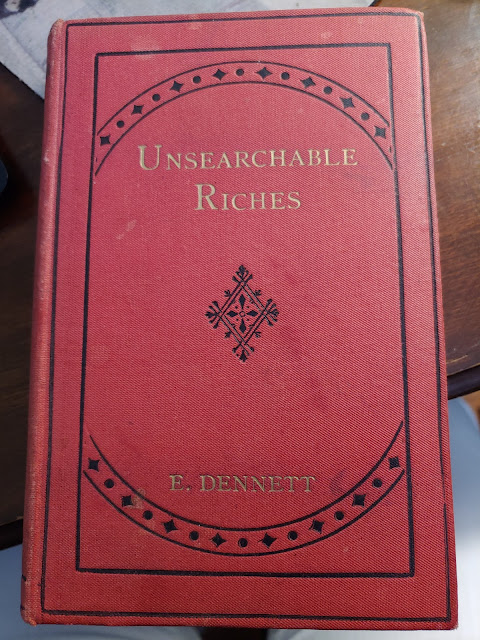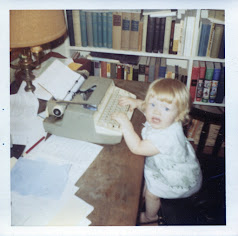Elizabeth "Bessie" Nimmo was one of my 2nd great-grandmothers. If you've been reading my posts for a while you have read her name before.
Bessie was born about 1841 in Ireland or Scotland and emigrated to Canada about 1851 with her mother, Elizabeth Louden, sisters Margaret and Martha and brother Charles. In 1867 she married John Dean at a Scottish Presbyterian church in Montreal and moved to the farm he had purchased six months earlier in Minton, now North Hatley, Quebec. John died at the young age of 49 in 1888 but Bessie was almost 83 when she died at the farm on March 21, 1924. Sometime after Bessie's death, some of her possessions were apparently put into storage in the attic of the farmhouse and remained there for decades.
More than seventy years after Bessie's death, following the death of my great-uncle Ken, my mother helped his daughter to clean out this attic and her labors were well rewarded; she brought home Bessie's photo album, which I have had for years and these two books which my mother gave to me last month.
It really is something to hold an object that belonged to an ancestor as far back as a 2nd great-grandparent, it gave me chills, but the great surprise was that the second book actually helped to confirm some information I found in census records.
A unique feature of the Canadian census, at least through 1921, is that it asked people their religion. This would be controversial today, to say the least, but I am grateful for the additional information about my ancestors because I might not have found it anywhere else.
In most census years, Bessie is listed with the same religion as the rest of her household but it changes from one census to the next. I haven't found the Nimmos in the 1861 census, the information is illegible in 1871, but the Deans are all listed as Congregational in 1881, Fellowship in 1891, and Methodist in 1901 and 1921. In 1911, however, when she was enumerated in the home of her daughter Anna and her family (Anna's husband was a Methodist minister), Bessie is listed as Plymouth Brethren. Perhaps it took a minister to recognize Bessie's right to be associated with her own faith, or maybe she was the only one home when the enumerator came by. Either way, I found this very interesting.
So, how do these books figure in all of this? Well, the first book does not really, except to tell us something about what was important to Bessie, but one of the fun things about the second book is that it was stamped by the bookseller.
The stamp is a bit difficult to read, but with the help of a 1921 Montreal city directory found on the BAnQ (Bibliothèque et Archives nationales du Quebec) website, I was able to confirm that the name of the seller was Bible and Tract Depot. Google did not return any results for this shop but did for a similarly named bookseller in London who, according to an article on enyclopedia.com, were publishers for the Plymouth Brethren for many years. Information about the author, Edward Dennett, can be found on a site called the Brethren Archive. He was considered a great preacher and teacher and was "converted" to the movement after meeting Brethren during his convalescence from an illness.
According to Wikipedia, the Plymouth Brethren are an "evangelical Christian movement whose history can be traced to Dublin, Ireland in the late 1820s..." which fits with other relationships in this family. Bessie's sister, Martha, married a man from Belfast, and her daughter, Maggie, also married an Irishman and Maggie and her husband gave their religions as Brethren on the 1911 and 1921 censuses.
Maggie's husband was William Thompson, by the way, and if you look at the inscription above, you'll see that the book was a gift from a James Thompson. I think I have found James in the 1921 census. It is a common name but in this area in 1921, there is only one James Thompson who lists his religion as Brethren. Also, he was, according to the census, a merchant, and may have made frequent trips to Montreal or even sold books in his own shop. Was he related to William? That may be harder to pin down and I am not actively researching this line at the moment, but it is an intriguing question that I would love to answer one day because all of this adds color and flavor to my knowledge of Bessie and Maggie, who died fairly young and without children.
The Plymouth Brethren do not seem to have had any churches in the Eastern Townships in Bessie's lifetime. In all of my research in the area, I have never seen church records attributed to a church of the Plymouth Brethren (it just occurred to me that this may be why I have never in my extensive searches found Bessie's burial record), but I am hoping that some historical society, archive or library somewhere in the Townships has some kind of record left behind by someone in the movement. We shall see!
If you have been lucky enough to inherit books that belonged to your ancestors, take some time to research the titles, the authors and anything else you might find in them. You just never know what they could reveal about your ancestor.






















